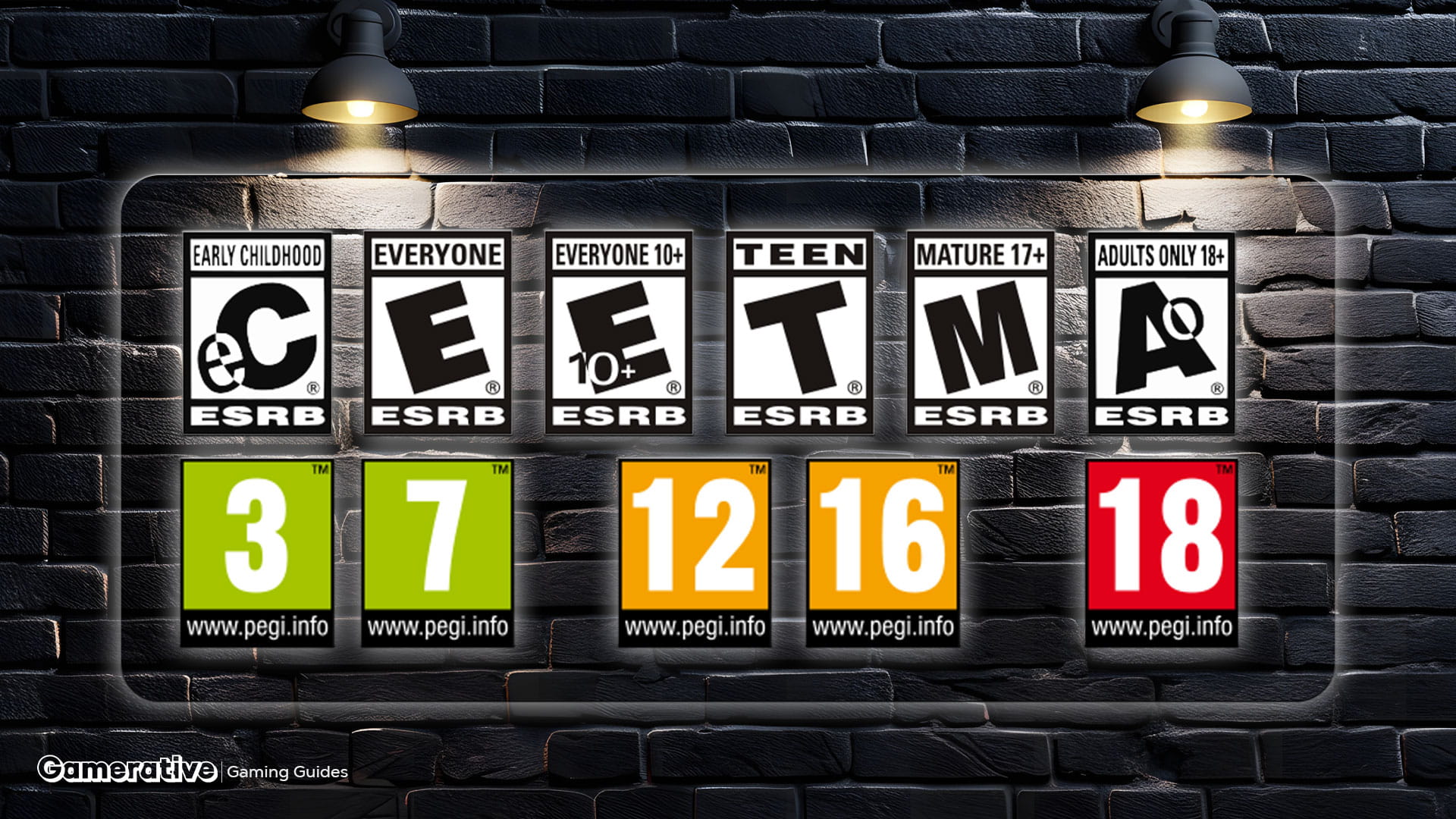Truth be told, nothing brings people together quite like video games, but not every game is a one-size-fits-all adventure. Some titles burst with colorful cartoons, while others drop us into intense battles or complex storylines that are best suited for more mature players. And for many of us, especially parents, that brings up the question: how do you know which games are appropriate and safe for different age groups? That’s exactly why it matters to know the answer to “What are PEGI ratings?”
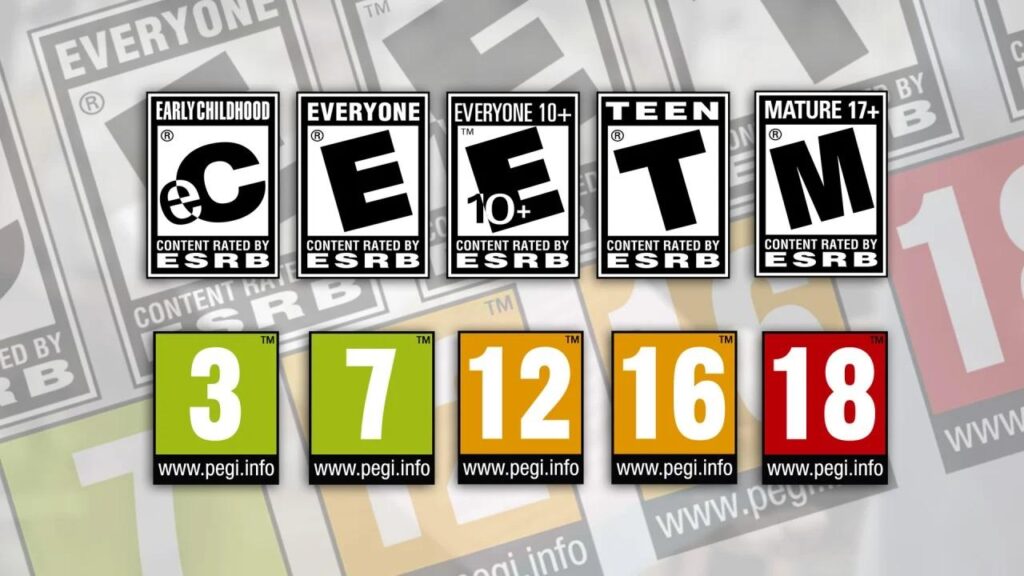
- The ESRB (Entertainment Software Rating Board) assigns age and content ratings to video games in North America.
What Are PEGI Ratings?
If you’ve ever checked the back of a game box or scrolled through the digital store for something new, those little age numbers and symbols probably caught your eye. They’re called PEGI ratings, and understanding them can make gaming choices so much easier. Introduced in 2003, PEGI (that’s Pan European Game Information) became the standard for video game content rating across most of Europe. Its mission? To help us, whether we’re parents, guardians, or just careful gamers, make informed decisions about what games to play and give.
1. Introduction: Why Game Age Ratings Matter
When our family sat down to pick out a new game for a weekend party, the youngest cousin gravitated toward whatever had the brightest cover; never mind the age label in the corner. That moment, as simple as it was, reminded us how vital age ratings can be. They give everyone, players, parents, and store clerks, a helpful guideline to quickly check what’s on the menu, so nobody gets more (or less) than they bargained for.
Across the world, different rating systems try to accomplish just that. But in Europe, PEGI stands out as the guiding light for responsible gaming.
2. PEGI Ratings
What are PEGI ratings? At heart, PEGI is a standardized system designed to rate the age suitability of video games and certain apps. This started back in 2003, unifying the mess of country-specific rules into one clear, trusted set of guidelines covering over 30 countries. Whether you’re in Spain or Sweden, picking up a game with a PEGI 12 or PEGI 18 mark means the same thing.
Game publishers and developers, including every big name you know, work closely with PEGI to ensure that new games get rated before reaching the shelves. It’s there for us as consumers, taking out the guesswork.
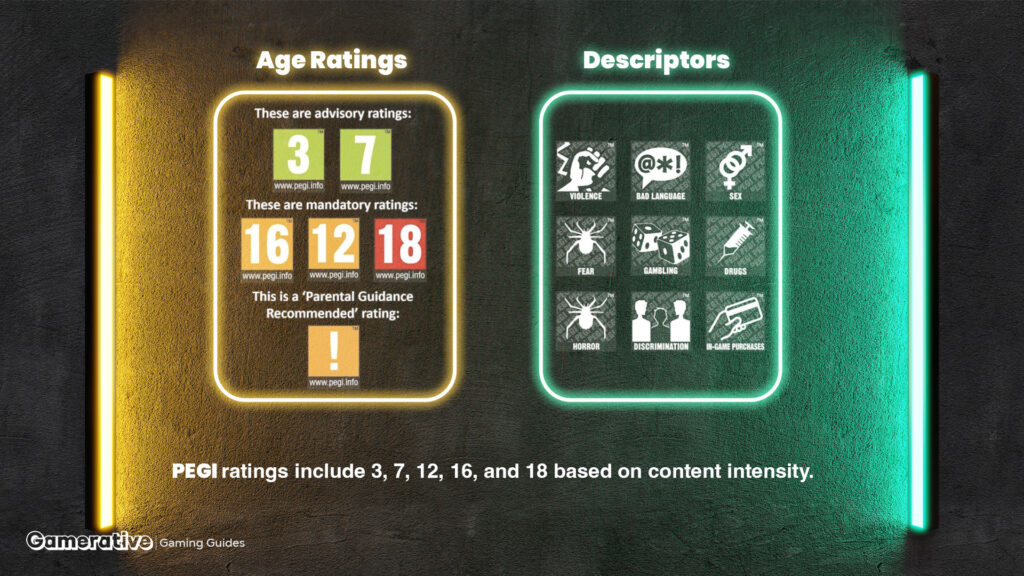
3. How Are PEGI Ratings Determined?
Behind every number sticker is a careful process. When a game is finished, the publisher submits detailed info and footage about its content to PEGI’s independent panel of experts. This group looks for violence, bad language, scary moments, references to sex or drugs; basically, anything that could affect younger players.
Next, based on set criteria, the game gets its official PEGI rating. These ratings are always made public before release and are updated if the game changes. That way, everything stays transparent and trustworthy, just the way we like it.
4. PEGI Rating Categories Explained
If you’ve ever wondered “what are PEGI ratings,” every PEGI symbol comes with a number and a color code to make things extra clear. Here’s the breakdown:
- PEGI 3: Suitable for all ages. No scary or inappropriate content. (Examples: 1. Mario Kart 8 Deluxe, 2. Just Dance 2024)
- PEGI 7: Some mild cartoon fantasy violence or hints of fear. (1. LEGO City Undercover, 2. Super Mario Odyssey)
- PEGI 12: More cartoon/cinematic violence, simple bad language, or slightly suggestive themes. (1. The Legend of Zelda: Breath of the Wild, 2. Overwatch)
- PEGI 16: Realism steps up. More graphic violence, strong language, or references to sex or drugs. (1. Fortnite, 2. Apex Legends, 3. The Witcher 3: Wild Hunt)
- PEGI 18: Designed for adults only. Heavy violence, explicit content, and themes that can be disturbing. (1. Grand Theft Auto V, 2. Resident Evil 7)
These categories aren’t just numbers; they’re designed to give us a quick snapshot of what we might see in a game. Color coding helps too; green for friendly games suitable for all, and dark red for those meant strictly for adults.
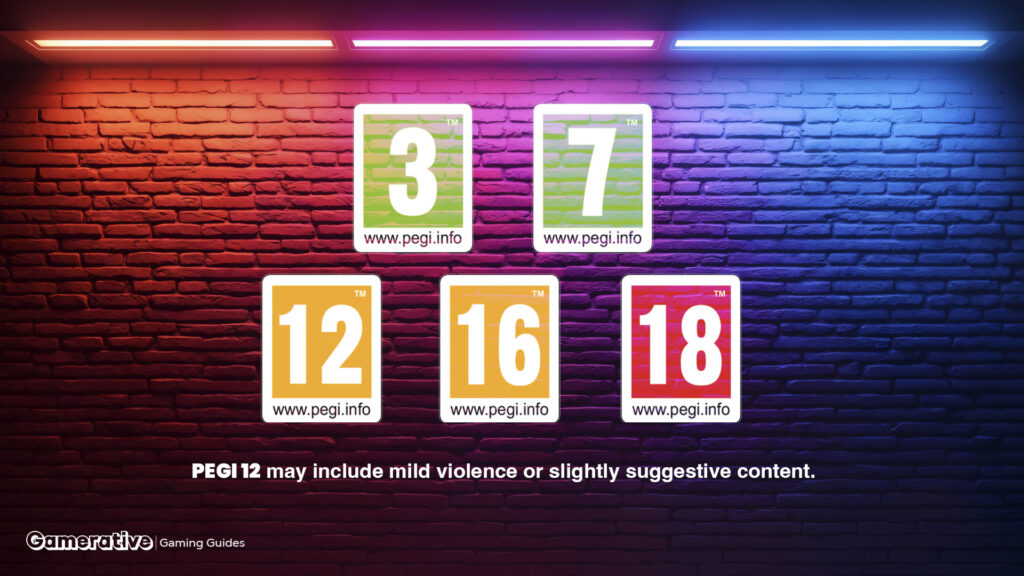
5. Understanding Content Descriptors
To understand “what are PEGI ratings” beyond just the age limits, PEGI also includes content descriptors that dive deeper into what a game contains. These little icons shine a light on specifics. For example, you might see:
- Violence: Indicates if there’s any violent content.
- Bad Language: Shows if there’s swearing or offensive language.
- Sexual Content: Flags any suggestive themes or scenes.
- Drug References: Warns about any reference to drugs or alcohol.
- Fear: Points out moments intended to scare.
These descriptors are valuable for insightful discussions among parents and kids about why certain content might or might not be appropriate. They clarify what we can expect beyond age ratings alone.
6. The Importance of PEGI Ratings for Parents
As parents, navigating the world of gaming can sometimes feel overwhelming. Ratings like PEGI help by providing a straightforward guide for selecting the right games for children. Imagine our family gathering; knowing that Animal Crossing: New Horizons has a PEGI 3 rating gives us peace of mind that it’s safe and suitable for everyone, without serious surprises.
Talking about games naturally leads to questions like “what are PEGI ratings” and why they matter, not just for the game’s content, but also for real-life lessons and themes. PEGI ratings encourage these important conversations. Checking PEGI’s website or the back of a game box can be an enlightening experience, helping parents make thoughtful choices before buying.
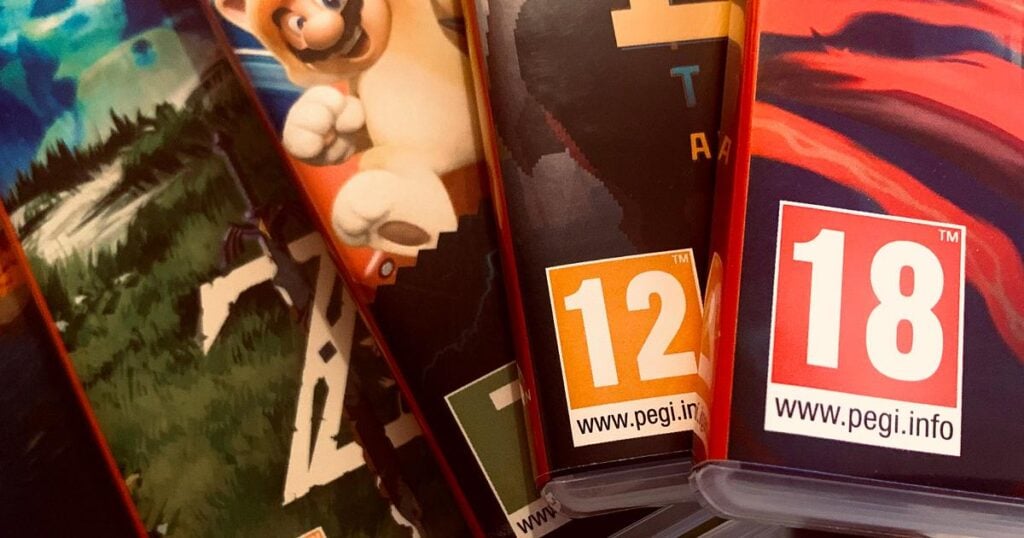
- PEGI 18 is reserved for mature content, such as intense violence and strong language.
7. Common Misconceptions About PEGI Ratings
Multiple myths swirl around PEGI ratings that can lead to confusion. For instance, many think PEGI is similar to quality ratings used in movies or TV shows, but that’s not the case. PEGI ratings are purely about age appropriateness, not quality.
Another misconception is that all PEGI-rated games are inherently violent or inappropriate. In reality, many beloved family games proudly sport PEGI 3 and 7 ratings. Understanding these distinctions helps demystify why a game earns its rating and alleviates fears.
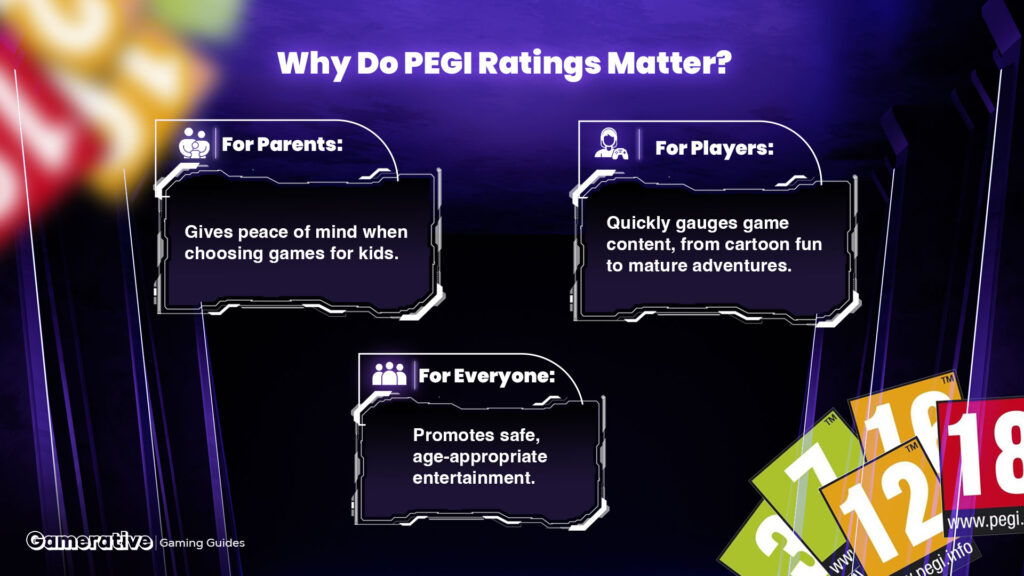
8. PEGI Ratings Around the World
As we look beyond Europe, it’s fascinating to see how other regions approach game ratings. For example, in the U.S., the ESRB (Entertainment Software Rating Board) provides similar guidance, but its categories and descriptors vary. In Japan, you have CERO (Computer Entertainment Rating Organization), reflecting different cultural perceptions of gaming content.
Each system has its nuances and shows how cultural attitudes towards gaming can shift around the globe. Recognizing these differences promotes a deeper understanding of our favorite pastimes.
9. Wrapping Up: The Role of PEGI Ratings in Gaming Culture
In closing, PEGI ratings are a crucial aspect of our gaming culture. They help protect players, especially the younger crowd, while empowering everyone to make smart, informed choices about the games we play. As gaming continues to evolve, embracing a thoughtful approach using PEGI ratings will ensure entertainment that is not just fun but also safe for all ages. So next time you pick up a game or make a recommendation, take a moment to ask yourself, “What are PEGI ratings?” and check them carefully. Remember, it’s about more than just playing; it’s about making choices that resonate positively with where we are in life. Have you ever found yourself surprised by a game’s rating? What are some games you’ve enjoyed despite their categorization? Share your thoughts in the comments below; let’s continue this important conversation!
Learn about the inside out of video games world and industry via Gamerative.
10. FAQs About PEGI Ratings
1. What happens if a game doesn’t have a PEGI rating?
It likely means the game hasn’t been submitted for assessment or isn’t intended for the European market. Always check with the publisher for content details before purchasing.
2. Can PEGI ratings change post-release?
Yes! If a game gets updates that significantly change its content, PEGI can reassess and potentially alter its rating.
3. How can I report misleading content for a game?
Consumers can reach out to PEGI directly through their website. They encourage feedback and take concerns about any misleading information seriously.
4. Why do some games not have a PEGI rating?
Certain indie or niche games might not go through the PEGI rating process due to budget constraints, or they may be distributed solely online, making ratings less critical.

